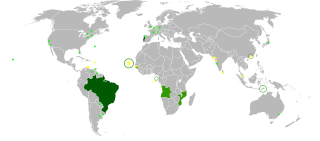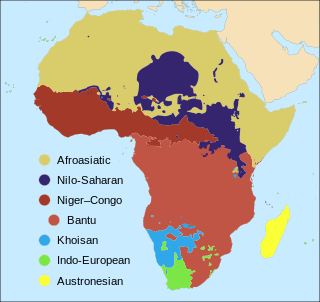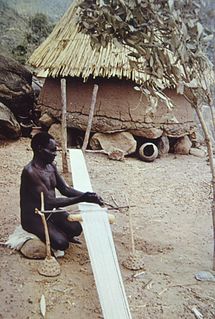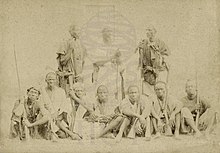
Guinea-Bissau, officially the Republic of Guinea-Bissau, is a country in West Africa that covers 36,125 square kilometres (13,948 sq mi) with an estimated population of 1,874,303. It borders Senegal to the north and Guinea to the south-east.

Portuguese is a Romance language originating in the Iberian Peninsula of Europe. It is the sole official language of Portugal, Angola, Mozambique, Guinea-Bissau, Cape Verde, São Tomé and Príncipe, and Brazil, while having co-official language status in East Timor, Equatorial Guinea, and Macau. A Portuguese-speaking person or nation is referred to as "Lusophone". As the result of expansion during colonial times, a cultural presence of Portuguese and Portuguese creole speakers is also found around the world. Portuguese is part of the Ibero-Romance group that evolved from several dialects of Vulgar Latin in the medieval Kingdom of Galicia and the County of Portugal, and has kept some Celtic phonology in its lexicon.

The languages of Africa are divided into several major language families:

The West Atlantic languages of West Africa are a major subgroup of the Niger–Congo languages.

The culture of Angola is influenced by the Portuguese. Portugal occupied the coastal enclave Luanda, and later also Benguela, since the 16th/17th centuries, and expanded into the territory of what is now Angola in the 19th/20th centuries, ruling it until 1975. Both countries share cultural aspects: language (Portuguese) and main religion. However, the Angolan culture is mostly native Bantu, which was mixed with Portuguese culture. The diverse ethnic communities with their own cultural traits, traditions and native languages or dialects include the Ovimbundu, Ambundu, Bakongo, Chokwe, Avambo and other peoples.

Portuguese creoles are creole languages which have Portuguese as their substantial lexifier. The most widely-spoken creoles influenced by Portuguese are Cape Verdean Creole, Guinea-Bissau Creole and Papiamento.

The Manding languages are a dialect continuum within the Mande language family spoken in West Africa. Their best-known members are Bambara, the most widely spoken language in Mali; Mandinka, the main language of the Gambia; Maninka, or Malinké, a major language of Guinea and Mali; and Jula, a trade language of the northern Ivory Coast and western Burkina Faso.
The lançados were settlers and adventurers of Portuguese origin in Senegambia, Cabo Verde, Guinea, Sierra Leone, and other areas on the coast of West Africa. Many were Jews—often New Christians—escaping persecution from the Portuguese Inquisition. Lançados often took African wives from local ruling families, securing protection and advantageous trading ties. They established clandestine trading networks in weaponry, spices, and oftentimes enslaved people, which angered the Portuguese Crown by disrupting its ability to collect taxes.

The Baga are a West African ethnic group who live in the southern swampy lands of Guinea Atlantic coastline. Traditionally animist through the pre-colonial times, they converted to Islam during the mid-eighteenth century under the influence of Muslim Mandé missionaries. Some continue to practice their traditional rituals.

The Asmat are an ethnic group of New Guinea, residing in the Papua province of Indonesia. The Asmat inhabit a region on the island's southwestern coast bordering the Arafura Sea, with lands totaling approximately 18,000 km² (7,336 mi²) and consisting of mangrove, tidal swamp, freshwater swamp, and lowland rainforest.
Fernandinos are creoles, multi-ethnic or multi-racial populations who developed in Equatorial Guinea. Their name is derived from the island of Fernando Pó, where many worked. This island was named for the Portuguese explorer Fernão do Pó, credited with discovering the region.
Guinea-Bissau Creole, also known as Kiriol or Crioulo, is a creole language whose lexicon derives mostly from Portuguese. It is spoken in Guinea Bissau, Senegal and The Gambia. It is also called by its native speakers as guinensi, kriyol, or portuguis.

The Jola or Diola are an ethnic group found in Senegal, the Gambia, and Guinea-Bissau. Most Jola live in small villages scattered throughout Senegal, especially in the Lower Casamance region. The main dialect of the Jola language, Fogni, is one of the six national languages of Senegal.

The languages of the African Union are languages used by citizens within the member states of the African Union (AU). For languages of the institution, see African Union: Languages.
There are diverse religions in Guinea-Bissau with no one religion having a majority. The CIA World Factbook states there are about 45% Muslims, 22% Christians, 15% Animists and 18% unspecified or other while the US State Department mentions that estimates vary greatly and cites the Pew Forum data (2010) of 40% Muslim, 31% indigenous religious practices, and 20% Christian. Sunni Islam, including that of Sufi-oriented, are most concentrated in the northern and northeastern parts of the country. Practitioners of traditional indigenous religious beliefs generally live in all but the northern parts of the country. Christians are mostly found along the coastal regions, and belong to the Roman Catholic Church and various Protestant denominations. Christians are concentrated in Bissau and other large towns.

The Balanta are an ethnic group found in Guinea-Bissau, Guinea, Senegal and The Gambia. They are the largest ethnic group of Guinea-Bissau, representing more than one-quarter of the population. Despite their numbers, they have remained outside the colonial and postcolonial state because of their social organisation. The Balanta can be divided into 7 clans: Nhacra, Ganja, Naga, Mane, Patch, Sofa and Kentohe. The largest of which are the Balanta Kentohe.
Senegalese Americans are an ethnic group of Americans of Senegalese descent. In the surveys of 2019, 18,091 people claimed to be of Senegalese origin or descent in the United States. However, many West Africans trafficked by enslavers to the United States were also of Senegalese origin. Thus many African Americans may also have some ancestors of this country.
Nalu is an Atlantic language of Guinea and Guinea-Bissau, spoken by the Nalu people, a West African people who settled the region before the arrival of the Mandinka in the 14th or 15th centuries. It is spoken predominantly by adults. It is estimated to be spoken by a range of 10,000 to 25,000 people, whereas Wilson (2007) reports that there are around 12,000 speakers. It is considered an endangered language due to its dwindling population of speakers.

The Mafa also called Mafahay, is an ethnic group localized in northern Cameroon, Northern Nigeria and also scattered in other countries like Mali, Chad, Sudan, Burkina Faso and Sierra Leone.














